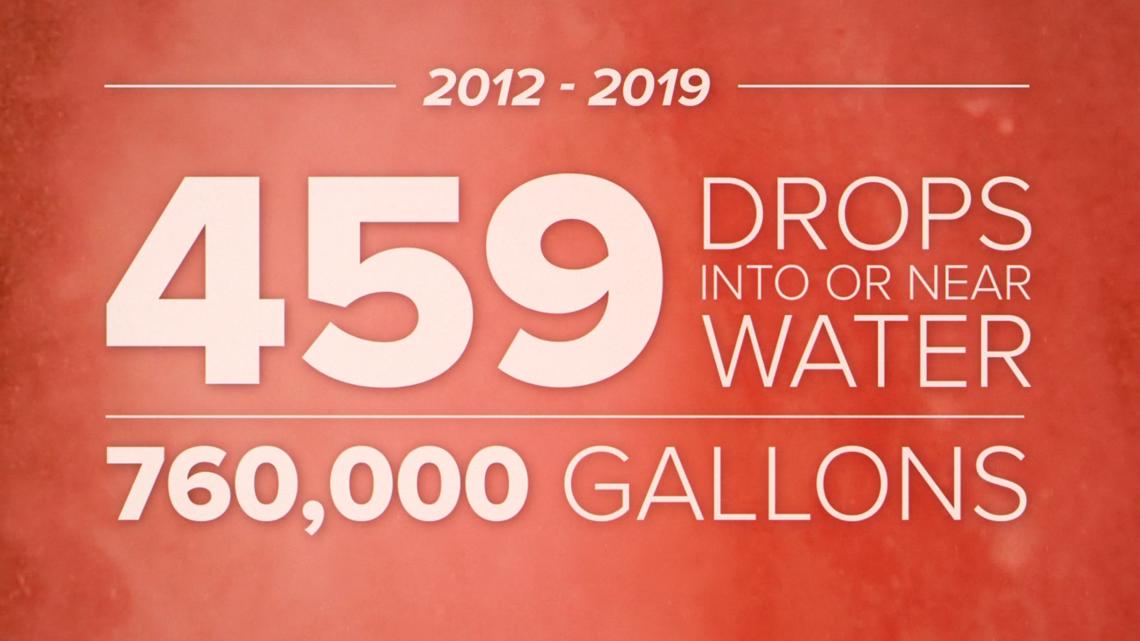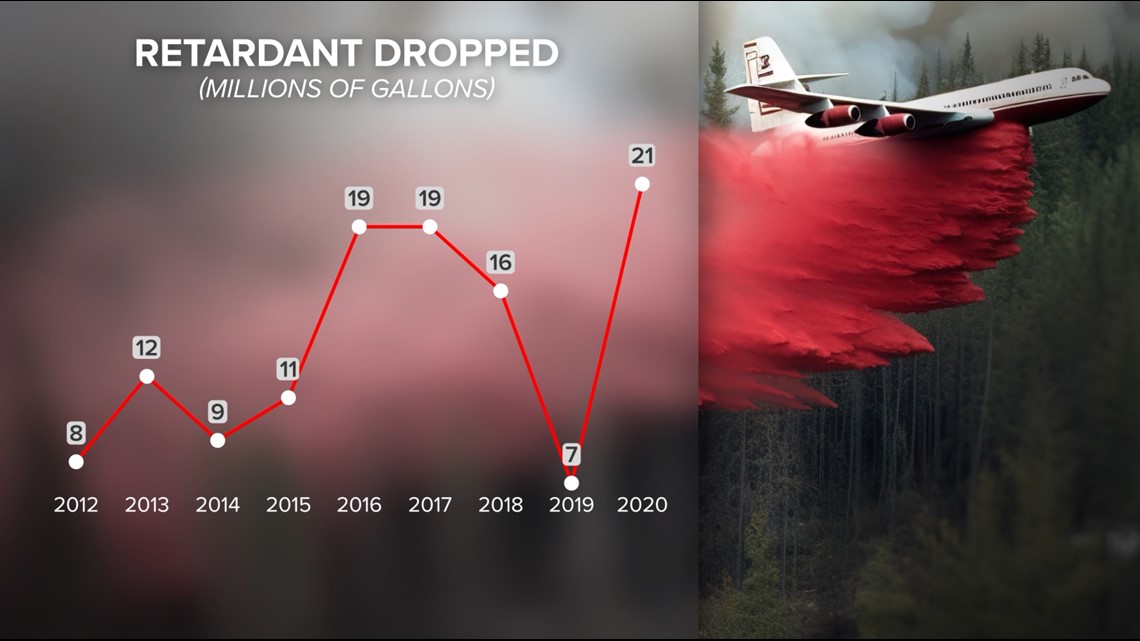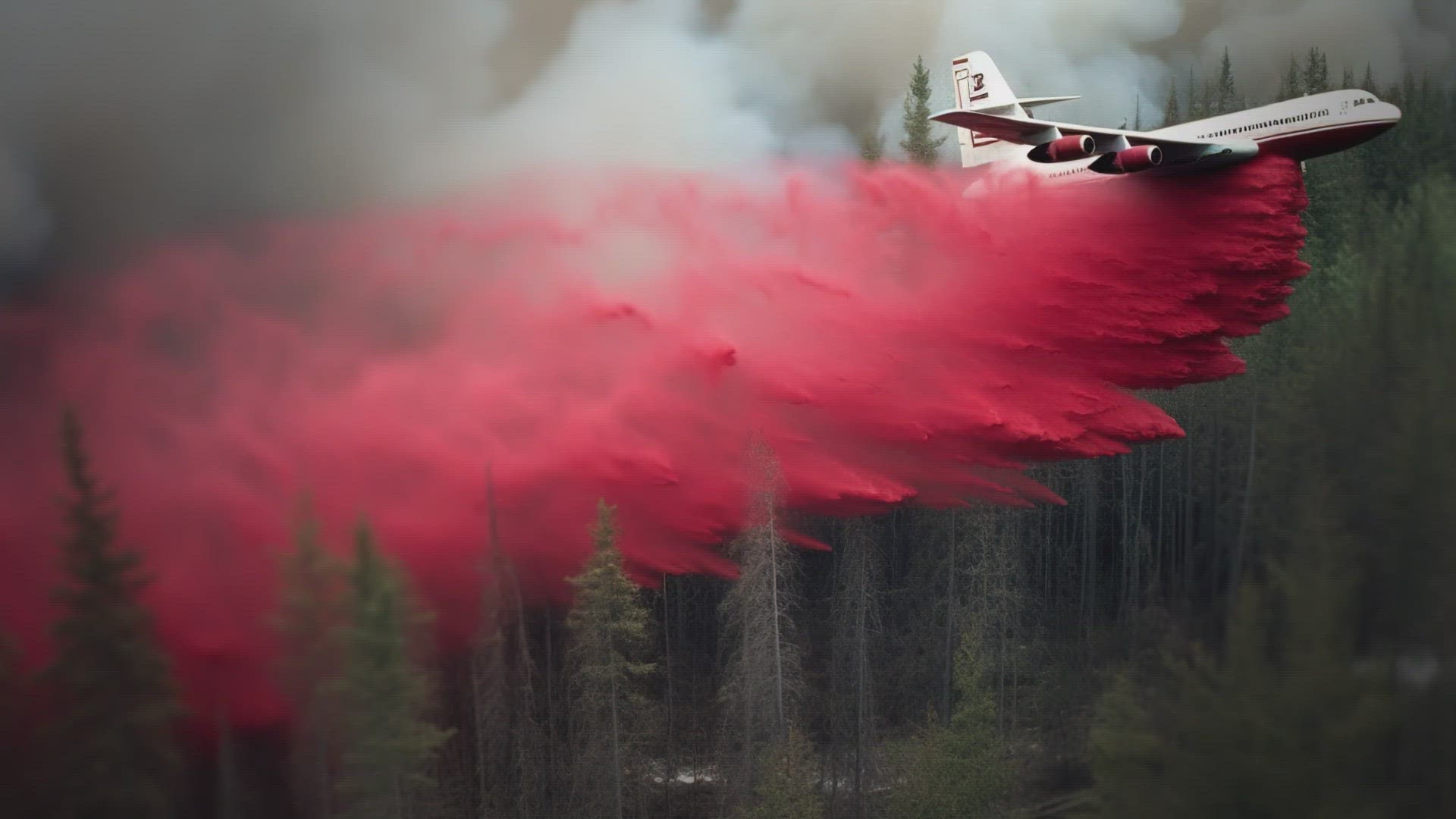OMAK, Wash. — The U.S. Forest Service (USFS) invented fire retardant in the 1950s and for decades the agency has said it’s one of the most important tools to slow the progression of fast-moving wildfires. But when the bright red retardant, dropped from aircraft, accidentally misses the mark and ends up in waterways, it can be lethal to aquatic life, including salmon and steelhead on the endangered species list.
The retardant contains ammonium phosphate – a high source of elemental nitrogen used as an ingredient in certain fertilizers used by farmers. It’s also highly toxic to fish and other aquatic life.
Thousands of steelhead were killed in Omak Creek on the Colville Indian Reservation in Eastern Washington in two retardant drops that mistakenly landed in the water in 2001 and again in 2003.
A decade before, the Confederated Tribes of the Colville Reservation began restoration efforts on the creek to rehabilitate historic steelhead and salmon spawning grounds. Fish populations were devastated by the construction and operation of a timber mill in the 1920s. But the restoration project experienced a major setback with the retardant drops. According to the U.S. Fish and Wildlife Service, the mistakes by the Forest Service brought “catastrophic environmental harm” to the fragile creek.
“It’s heartbreaking,” said Colville Indian Tribe member Vertis Campbell, who lives just yards from Omak Creek. “That’s what we’re working for, to get all the fish to come back. That’s our heritage. That’s what we do. That’s a big thing in our life. (A fish kill caused by the Forest Service) is very sad.”
For 70 years, the USFS didn’t track or report how much retardant was mistakenly getting dropped into waterways. Litigation from 2010 required the agency to start keeping records. Last year, they reported the numbers publicly for the first time.
From 2012 to 2019, the USFS dropped retardant into or near water 459 times, all on the West Coast. The drops totaled 760,000 gallons, according to the USFS. KING 5 found that includes 45 drops in the northwest, including waterways in the Gifford Pinchot and Okanagan-Wenatchee National Forests.


“I was blown away, that the Forest Service’s error rate was so high,” said Andy Stahl, executive director of the Oregon-based non-profit Forest Service Employees for Environmental Ethics (FSEE). “Here we’ve got the agency charged with protecting that water actually being the biggest polluter of that water out there.”
The USFS sent KING 5 a statement that said fire retardant is critical for wildland firefighting.
“Ensuring we can continue to use retardant to protect homes and communities is a priority. We believe retardant can be (and has been) delivered without compromising public health and the environment,” wrote USFS National Press Officer John Winn.
In March, USFS Deputy Chief Chris French testified before a congressional committee that they make every effort to use retardant safely.
“We are incredibly careful and precise in our use of fire retardant,” said Deputy Chief French. “The use of fire retardant is a critical wildfire suppression tool that we will continue to use appropriately and widely to protect communities form the threats of wildfire.”
The nonprofit FSEE has successfully sued the USFS three times over the use of fire retardant. After the numbers on drops into waterways were released last year, the organization filed a lawsuit accusing the agency of violating federal law, the Clean Water Act. The Act makes it unlawful to discharge any pollutant from a point source (such as an airplane) into waterways unless an EPA permit is obtained. A permit contains limits on what is discharged to ensure the toxins don’t harm water quality or human health. It also creates monitoring and reporting requirements.
For years the USFS argued it didn’t need a permit. In 2011, based on information from the USFS, the EPA issued a determination that due to the Forest Service policy of keeping retardant drops at least 300 feet away from rivers and lakes, an EPA permit wouldn’t be required.
But the Forest Service’s own records showed the goal of keeping a 300-foot buffer zone around water doesn’t always pan out.
In May, a federal judge sided with the FSEE, ruling the Forest Service is violating the Clean Water Act and the agency does need to obtain a permit.
“They look at this firefighting as a war where it doesn’t matter how much collateral damage they cause,” said FSEE Executive Director Stahl.
Non-toxic alternatives?
To investigate alternatives to the use of toxic chemicals, KING 5 traveled to Chico, California, to meet a team who has researched and developed possible options. The Chico-based company GreenFire has created the only fire suppression products to be NSF White Book listed, which means they meet USDA standards for being safe enough to even use near food production.
In 2021, GreenFire founders met with Forest Service top brass to discuss considering their non-toxic alternatives. There was no follow-up from the agency.
“Not much of a response at all. It was pretty much dismissed from the beginning,” said GreenFire CEO Brandon Miller. “We know we have a product that does not harm the environment. Water is so precious. We hear about it constantly on the West Coast. So you’d think you’d take every measure to protect that for the future.”
It’s unclear why the agency wouldn’t discuss other options with GreenFire. Forest Service records show as wildfire seasons have become longer and more intense, use of the current formula has increased over the years.
In 2012, the USFS dropped 8 million gallons of retardant from aircraft in firefighting efforts. In 2020, the amount shot up to 21 million gallons.


The Forest Service said they are open to improving their formula.
“The Forest Service continually works to improve formulations to minimize potential adverse impacts from retardant while maintaining or improving its effectiveness. In recent years, several companies have approached the Forest Service with various products intended to extinguish fire. These products go through a lengthy review process to determine their safety and effectiveness,” wrote Winn of the USFS.
The federal court ruling in May included a finding that the USFS must get a permit to comply with the Clean Water Act. That could take two to three years. In the meantime, the judge ruled the agency can keep using their current retardant.
Vertis Campbell of the Colville Indian Tribe said while doing so, he hopes the Forest Service thinks about his tribe, their water, and the salmon that form the foundation of their culture.
“It’s like life. That’s what brings life to us. Every stream on this reservation is very important," Campbell said. “That’s our life.”

